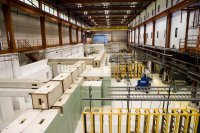 |
 |
|||||||||||||
|
|||||||||||||
|
|||||||||||||
|
As ILC research and development efforts ramp up around the world, Fermilab is preparing to make an important contribution. Engineers and technicians at the labís new ILC Test Area (ILCTA) have worked hard all summer creating a state-of-the-art cryomodule test facility, and the infrastructure is almost complete. Located at the end of an old accelerator beam line, the ILCTA has taken up residence in the New Muon Lab (NML). The former inhabitant of the building was the 2000-ton Chicago cyclotron magnet, which had lain dormant for many years. After removing this behemoth, workers cleared out the building and sealed the floors, making way for the new construction that took place over the past few months. The most striking feature inside the ILCTA is the 50-metre-long cave needed to house the test equipment. Construction of this mammoth structure is nearly finished except for a few coats of paint and the roof, which will be added once a crane lowers the machines into place. Tenants of the cave will include accelerator components, the cryomodules, and associated support systems. When assembly is complete, a radio frequency gun and photo-injector mechanism will fire a beam of electrons through the cryomodules to create a miniature version of the ILC. Users from around the world will then be able to use the apparatus to conduct a number of ILC R&D related tests. Cryomodules are a highly complicated technology, so working out any bugs on a small scale is important. Furthermore, the ILCTA will test different kinds of cryomodules to determine which is best for the ILC. Other purposes include testing control systems, diagnostics, and instrumentation. Aside from the basic infrastructure, the other key element of the test facility is its cryogenic system. The cryomodules in the ILCTA must be kept at temperatures near absolute zero to operate properly. While a series of three cryosystem phases are planned, the first has already been completed. Engineers and technicians recently installed the first refrigerator along with its related equipment. Not quite your typical icebox, this large cylindrical device will be sufficient to provide cooling to the first cryomodule. Other developments around the ILCTA include installation of the electronics racks along the outside of the cave and the freshly refurbished control room. The ILCTA team expects to receive the first cryomodule in November. A team in another Fermilab facility has just begun to assemble this module from a “kit” provided by the German lab DESY and expect to be finished within four months. In the meantime, technicians will complete piping and electrical work and install the radio frequency (RF) systems needed to power the equipment. Near-term plans for the Test Area include a second cryomodule scheduled to arrive in 2008. Further down the road, ILCTA team members plan to add an extension to the New Muon Lab that would not only allow for three modules (a full ILC RF unit), but also provide enough room for an additional three, making two complete units. Other additions include a new cryoplant and beam dump. -- J. Bryan Lowder |
|||||||||||||
| © International Linear Collider |
